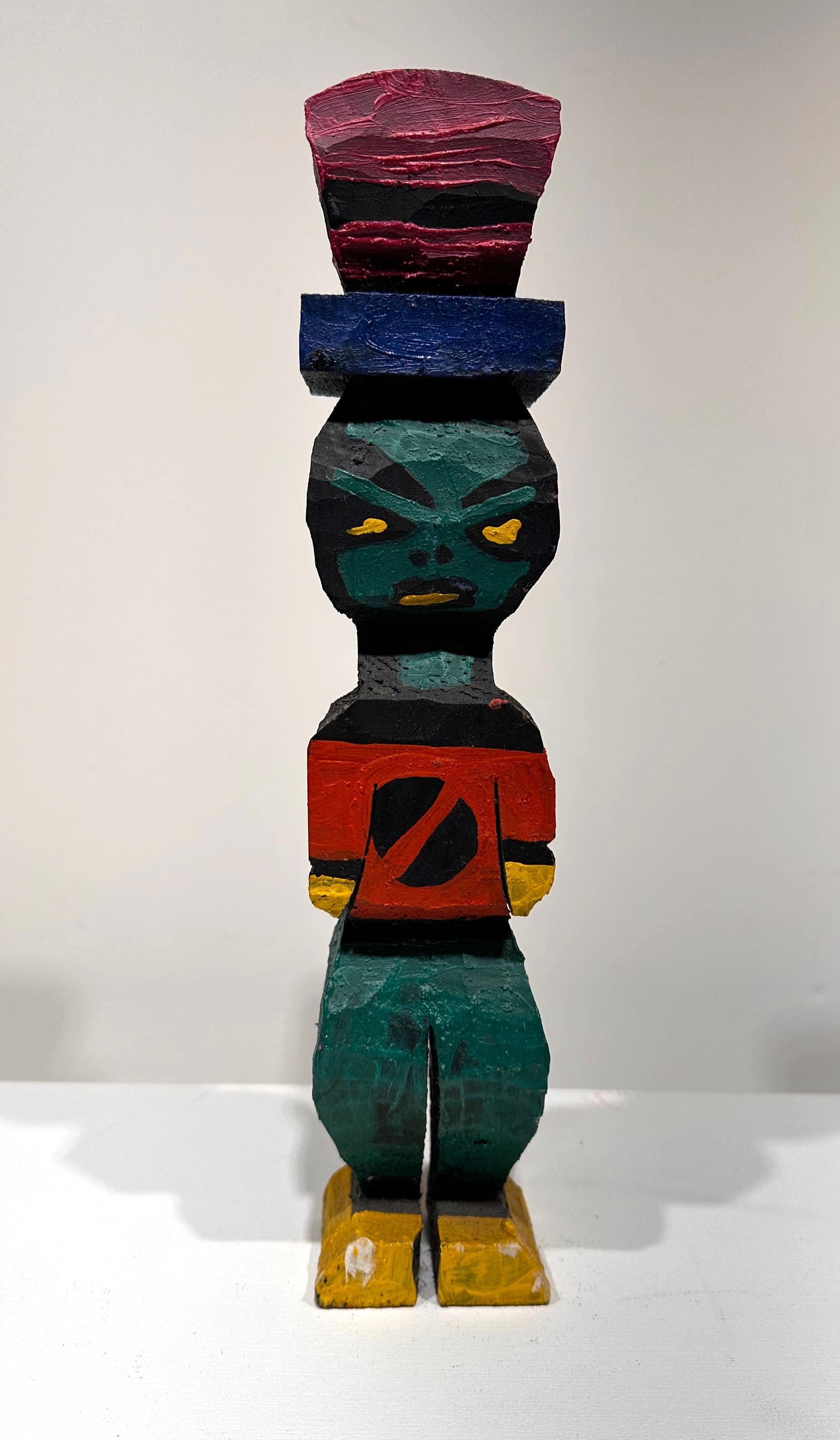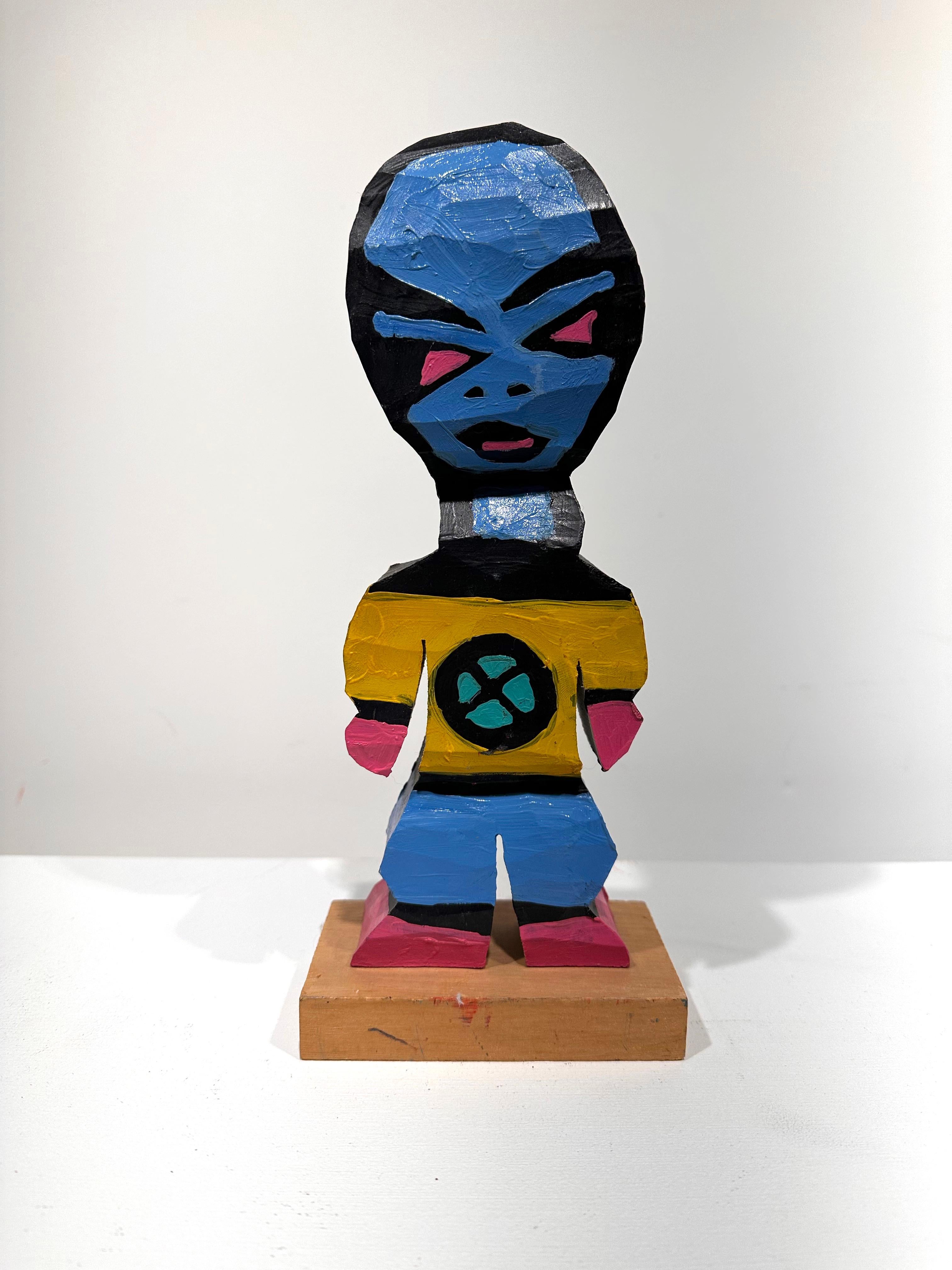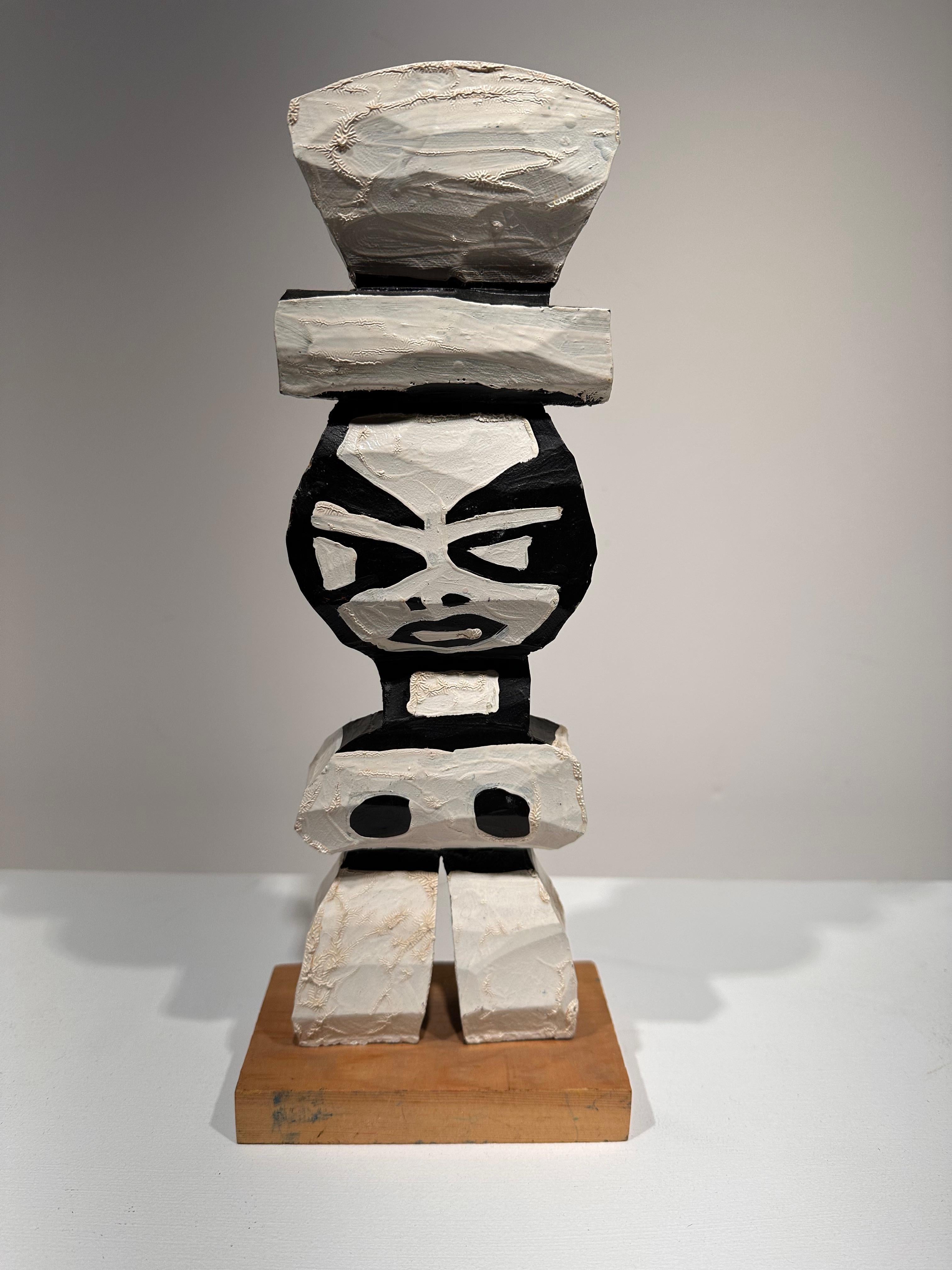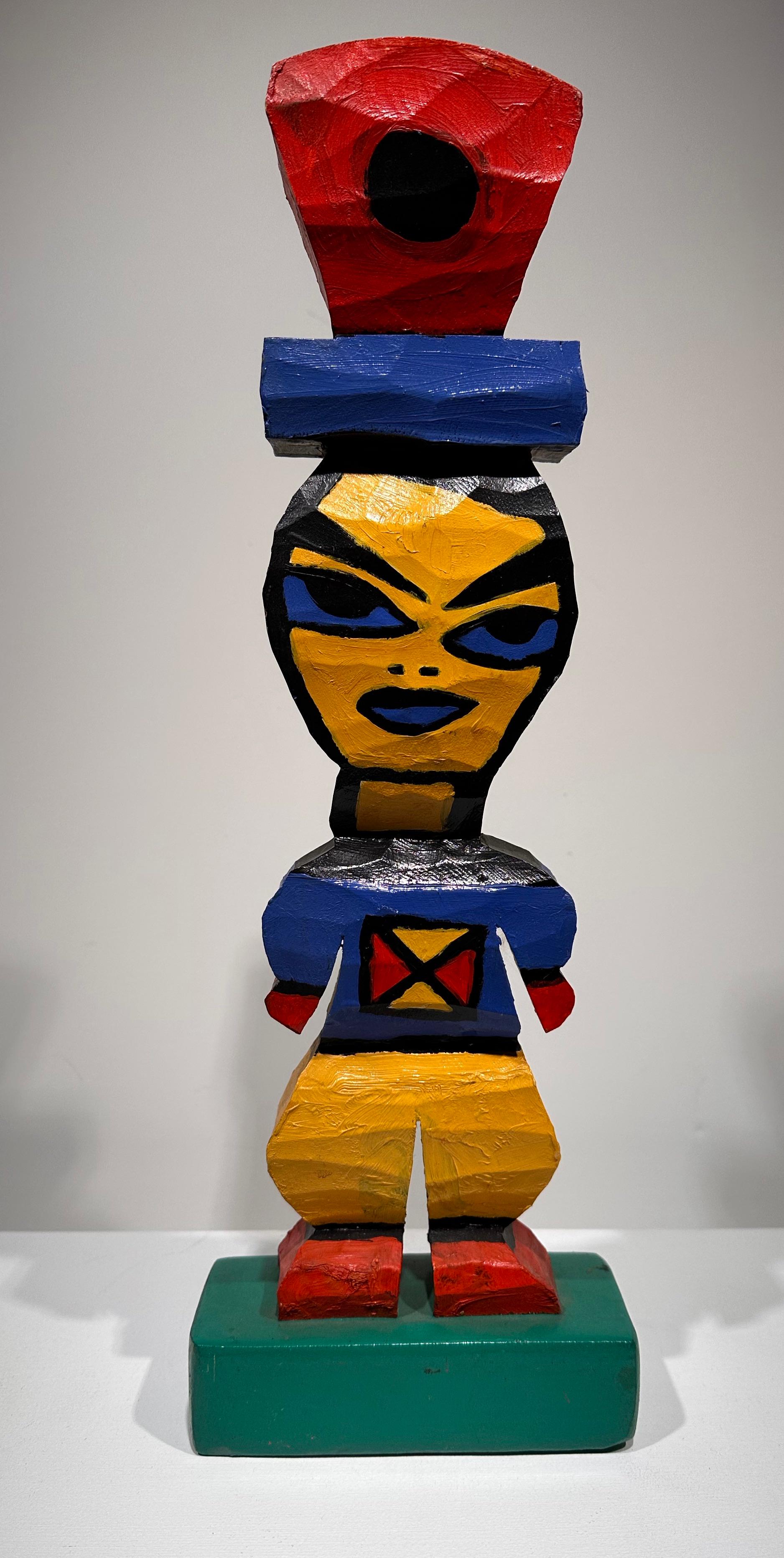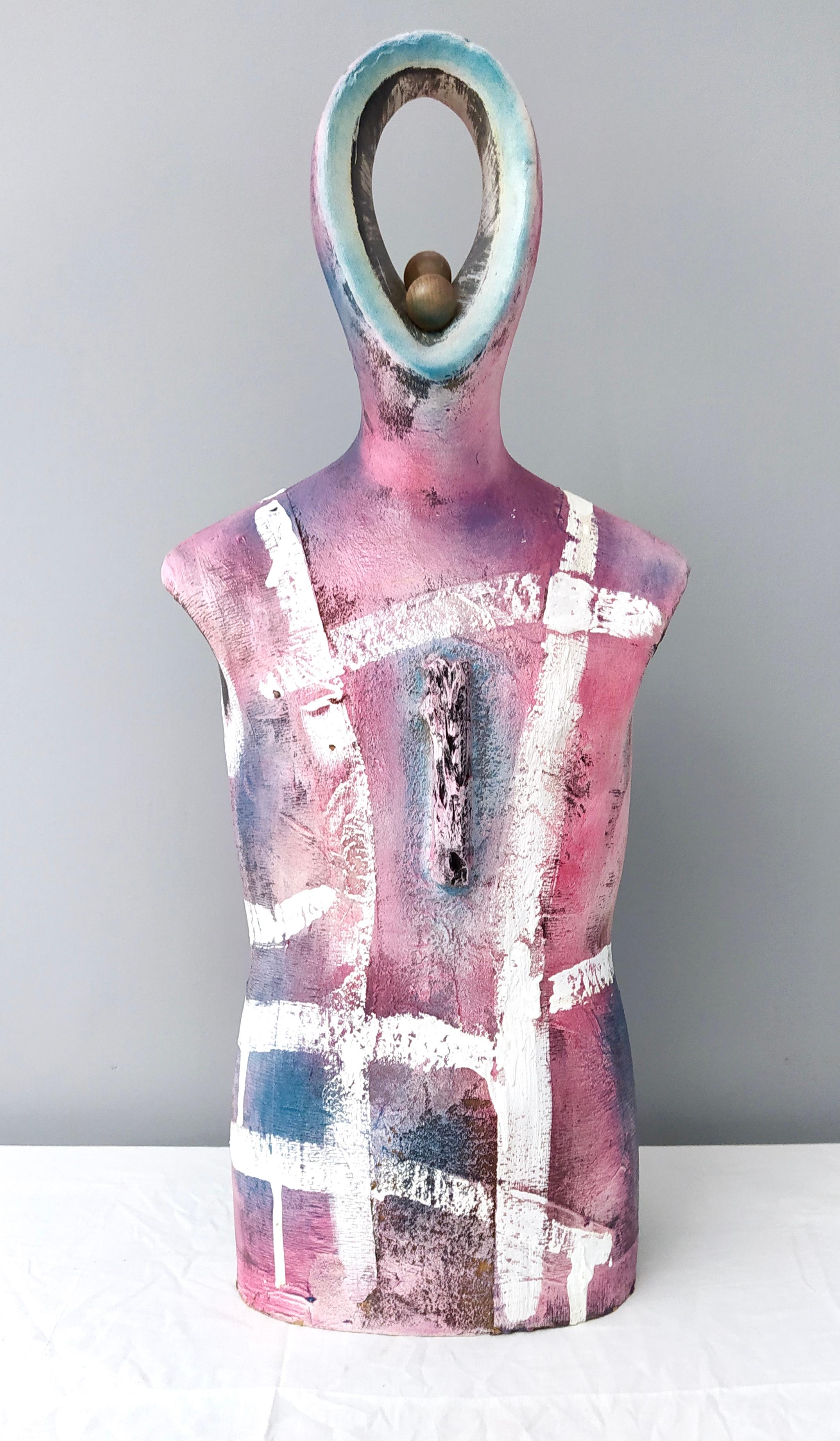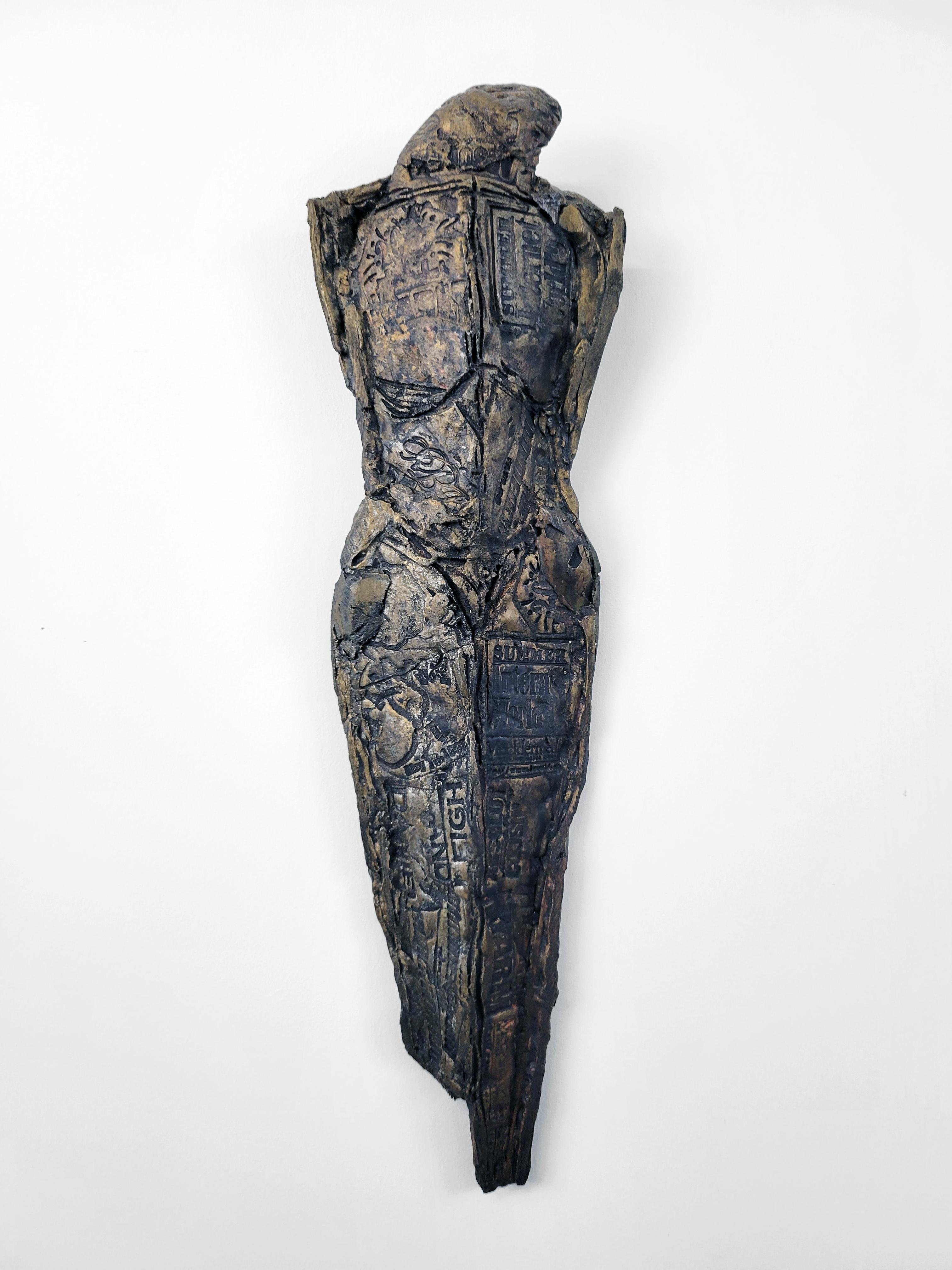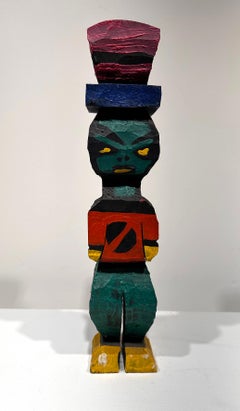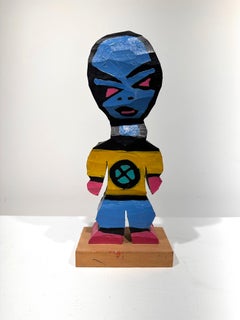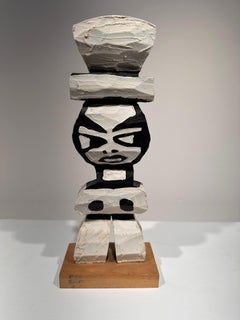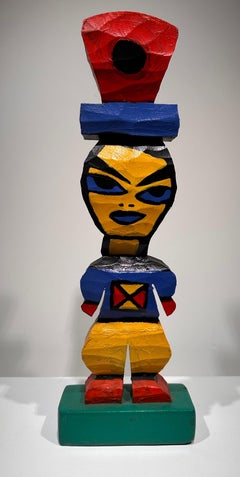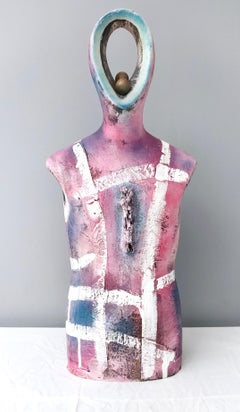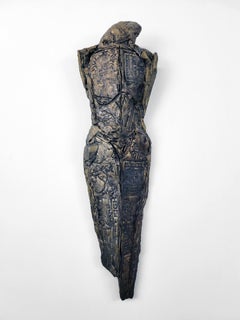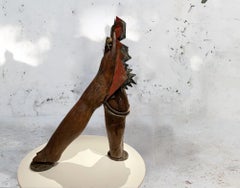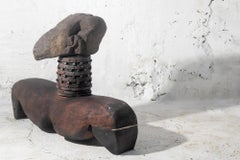Items Similar to Standing Figure
Want more images or videos?
Request additional images or videos from the seller
1 of 5
Tom CramerStanding Figure1980
1980
About the Item
Tom Cramer (b.1960). Standing Figure, 1980. Carved wood and polymer paint. Measures 11.5 inches high. Excellent condition. Signed and dated under base.
Tom Cramer is an American artist working in Portland, Oregon noted for his intricately carved and painted wood reliefs and ubiquity throughout the city of Portland. Often called the unofficial Artist Laureate of Portland,[2] Cramer is one of the most visible and successful artists in the city. The influences on his work are both organic and technological. He is widely collected and is in many prominent west coast museum and private collections. He is in the permanent collections of the Portland Art Museum[3] in Portland Oregon, the Halle Ford Museum in Salem Oregon, the Jordan Schnitzer Museum in Eugene, Oregon, the Boise Art Museum in Idaho.
Cramer made a name for himself in the 1980s and 1990s becoming a bridge between historical Oregon artists like Clifford Gleason and Milton Wilson and the international influx of new artists to the city since the mid-1990s. Tom Cramer grew up in Portland, Oregon in a musical family and played French horn in the Portland Youth Philharmonic in the late 1970s. He first started drawing in 1973 during this period and gradually became more interested in visual art. His first serious art classes in high school were followed by later instruction at the Museum Art School (later called the Pacific NW College of Art) in Portland, Oregon as well as Pratt Institute in New York. Cramer went to the same high school as Gus Van Sant and appeared briefly in his feature film My Own Private Idaho. A Cramer painted VW Van appeared in Van Sant’s Even Cowgirls Get the Blues. While in New York - Cramer encountered the likes of many artists including Keith Haring, Jean-Michel Basquiat, Mike Bidlo, Kent Floeter. The Primitive/Modern show and High/Low shows had special influence as did the burgeoning East Village art scene. Cramer returned to Portland, Oregon in the mid-1980s and quickly became well known via many shows at the Folkcraft Gallery and later the Jamison Thomas Gallery. There he expanded his show base to Los Angeles and San Francisco - as well as the Jamison Thomas Gallery in New York. He later had one person shows at the Blue Gallery, the Butters Gallery, the Pulliam Gallery as well as the Mark Woolley Gallery. From 2006 - 2013, he was with the Laura Russo Gallery. Currently he is represented by The Augen Gallery in Portland and the Imogen Gallery in Astoria. A show of carved wood reliefs and drawings for the Jordan Schnitzer Museum of Art took place in Fall 2019. Tom Cramer has always been heavily influenced by classical as well as modern popular music. He has cited an improvisational approach to his creative process that is not unlike a musical approach. Key musical influences include Bach, Beethoven, Bruckner, Klaus Schulze, Future Sound of London and Miles Davis. He became well known in the 1980s and 1990s for his painted cars as well as large scale colorful murals. He later designed costumes and sets for James Canfield's, "Jungle" with a soundtrack by the Future Sound of London. In the 1980s, he began his painted and carved wood reliefs which became his most noteworthy works. He also does carved/painted furniture and objects, as well as continuing his work in drawing and oil painting. His best known mural, "Machine", from 1989 was demolished in 2017. However, he has recently been doing a series of new murals around Portland, Oregon. Several recent trips to India, Egypt and Europe have expanded his base of influences.
Tom Cramer continues to work in a variety of media - including drawing, painted relief carving, murals and oil on canvas paintings.
- Creator:Tom Cramer (1960, American)
- Creation Year:1980
- Dimensions:Height: 12 in (30.48 cm)Width: 4.75 in (12.07 cm)Depth: 2.75 in (6.99 cm)
- Medium:
- Movement & Style:
- Period:
- Condition:
- Gallery Location:Wilton Manors, FL
- Reference Number:1stDibs: LU245211945392
About the Seller
4.9
Platinum Seller
Premium sellers with a 4.7+ rating and 24-hour response times
Established in 2007
1stDibs seller since 2015
387 sales on 1stDibs
Typical response time: 3 hours
- ShippingRetrieving quote...Shipping from: Wilton Manors, FL
- Return Policy
Authenticity Guarantee
In the unlikely event there’s an issue with an item’s authenticity, contact us within 1 year for a full refund. DetailsMoney-Back Guarantee
If your item is not as described, is damaged in transit, or does not arrive, contact us within 7 days for a full refund. Details24-Hour Cancellation
You have a 24-hour grace period in which to reconsider your purchase, with no questions asked.Vetted Professional Sellers
Our world-class sellers must adhere to strict standards for service and quality, maintaining the integrity of our listings.Price-Match Guarantee
If you find that a seller listed the same item for a lower price elsewhere, we’ll match it.Trusted Global Delivery
Our best-in-class carrier network provides specialized shipping options worldwide, including custom delivery.More From This Seller
View AllStanding Figure
Located in Wilton Manors, FL
Tom Cramer (b.1960). Standing Figure, 1988. Carved wood and polymer paint. Measures 11.5 inches high. Excellent condition. Signed and dated under base.
Tom Cramer is an American artist working in Portland, Oregon noted for his intricately carved and painted wood reliefs and ubiquity throughout the city of Portland. Often called the unofficial Artist Laureate of Portland,[2] Cramer is one of the most visible and successful artists in the city. The influences on his work are both organic and technological. He is widely collected and is in many prominent west coast museum and private collections. He is in the permanent collections of the Portland Art Museum[3] in Portland Oregon, the Halle Ford Museum in Salem Oregon, the Jordan Schnitzer Museum in Eugene, Oregon, the Boise Art Museum in Idaho.
Cramer made a name for himself in the 1980s and 1990s becoming a bridge between historical Oregon artists like Clifford Gleason and Milton Wilson...
Category
Late 20th Century Neo-Expressionist Figurative Sculptures
Materials
Wood, Latex
Standing Figure
Located in Wilton Manors, FL
Tom Cramer (b.1960). Standing Figure, 1998. Carved wood and polymer paint. Measures 10.25 inches high. Excellent condition. Signed and dated under base.
Tom Cramer is an American artist working in Portland, Oregon noted for his intricately carved and painted wood reliefs and ubiquity throughout the city of Portland. Often called the unofficial Artist Laureate of Portland,[2] Cramer is one of the most visible and successful artists in the city. The influences on his work are both organic and technological. He is widely collected and is in many prominent west coast museum and private collections. He is in the permanent collections of the Portland Art Museum[3] in Portland Oregon, the Halle Ford Museum in Salem Oregon, the Jordan Schnitzer Museum in Eugene, Oregon, the Boise Art Museum in Idaho.
Cramer made a name for himself in the 1980s and 1990s becoming a bridge between historical Oregon artists like Clifford Gleason and Milton Wilson...
Category
Late 20th Century Neo-Expressionist Figurative Sculptures
Materials
Wood, Latex
Standing Figure
Located in Wilton Manors, FL
Tom Cramer (b.1960). Standing Figure, 1998. Carved wood and polymer paint. Measures 12 inches high. Excellent condition. Signed and dated under base.
Tom Cramer is an American artist working in Portland, Oregon noted for his intricately carved and painted wood reliefs and ubiquity throughout the city of Portland. Often called the unofficial Artist Laureate of Portland,[2] Cramer is one of the most visible and successful artists in the city. The influences on his work are both organic and technological. He is widely collected and is in many prominent west coast museum and private collections. He is in the permanent collections of the Portland Art Museum[3] in Portland Oregon, the Halle Ford Museum in Salem Oregon, the Jordan Schnitzer Museum in Eugene, Oregon, the Boise Art Museum in Idaho.
Cramer made a name for himself in the 1980s and 1990s becoming a bridge between historical Oregon artists like Clifford Gleason and Milton Wilson...
Category
Late 20th Century Neo-Expressionist Figurative Sculptures
Materials
Wood, Latex
Standing Figure
Located in Wilton Manors, FL
Tom Cramer (b.1960). Standing Figure, 1998. Carved wood and polymer paint. Measures 17.5 inches high. Excellent condition. Signed and dated under base.
Tom Cramer is an American artist working in Portland, Oregon noted for his intricately carved and painted wood reliefs and ubiquity throughout the city of Portland. Often called the unofficial Artist Laureate of Portland,[2] Cramer is one of the most visible and successful artists in the city. The influences on his work are both organic and technological. He is widely collected and is in many prominent west coast museum and private collections. He is in the permanent collections of the Portland Art Museum[3] in Portland Oregon, the Halle Ford Museum in Salem Oregon, the Jordan Schnitzer Museum in Eugene, Oregon, the Boise Art Museum in Idaho.
Cramer made a name for himself in the 1980s and 1990s becoming a bridge between historical Oregon artists like Clifford Gleason and Milton Wilson...
Category
Late 20th Century Neo-Expressionist Figurative Sculptures
Materials
Wood, Latex
Abstract Figure
By Raul Diaz
Located in Wilton Manors, FL
Raul Diaz (Argentina, b.1950). Abstract Figure, ca. 1970s. Canved Walnut. Measures 17 inches tall including wood base. Carved signature in lower region. Excellent condition.
An ear...
Category
1970s Abstract Expressionist Abstract Sculptures
Materials
Walnut
$1,200
Reaching (bronze hand)
Located in Wilton Manors, FL
Reaching, ca. 1980. Cast bronze. Signed in lower region on wrist.
A rare example from the artist's later period influenced by figurative abstraction with expressionist tendencies.
James Edward Lewis (August 4, 1923 – August 9, 1997) was an African-American artist, art collector, professor, and curator in the city of Baltimore. He is best known for his role as the leading force for the creation of the James E. Lewis Museum of Art, an institution of the HBCU Morgan State University. His work as the chairman of the Morgan Art Department from 1950 to 1986 allowed for the museum to amass a large collection of more than 3,000 works, predominantly of African and African diasporan art.[1] In addition, he is also well known for his role as an interdisciplinary artist, primarily focused on sculpture, though also having notable examples of lithography and illustration. His artistic style throughout the years has developed from an earlier focus on African-American history and historical figures, for which he is most notable as an artist, to a more contemporary style of African-inspired abstract expressionism.
Early and personal life
James E. Lewis was born in rural Phenix, Virginia on August 4, 1923 to James T. Lewis and Pearline (Pearlean) Harvey.[5] Lewis' parents were both sharecroppers. Shortly after his birth, his father moved to Baltimore for increased job opportunity; James E. was subsequently raised by his mother until the family was reunited in 1925. They lived for a short time with distant relatives until moving to a four-bedroom house on 1024 North Durham Street in East Baltimore, a predominantly African-American lower-class neighborhood close to Johns Hopkins Hospital. Lewis' primary school, PS 101, was the only public school in East Baltimore that served black children. Lewis grew up in a church-going family, his parents both active members of the Faith Baptist Church, devoting the entirety of their Sundays to church activities. His parents worked a variety of different jobs throughout his youth:[6] his father working as a stevedore for a shipping company, a mechanic, a custodian, a mailroom handler,[6] and an elevator operator.] His mother worked as both a clerk at a drugstore[7] and a laundress for a private family.[4]
Lewis' primary exposure to the arts came from Dr. Leon Winslow, a faculty member at PS 101 who Lewis saw as "providing encouragement and art materials to those who wanted and needed it." In fifth grade, Lewis transferred to PS 102. Here, he was able to receive specialized Art Education in Ms. William's class under the guidance of Winslow. He was considered a standout pupil at PS 102 as a result of his introduction to the connection between the arts and the other studies. His time spent in Ms. Pauline Wharton's class allowed for him to experiment with singing, to which he was considered a talented singer. His involvement in this class challenged his earlier belief that singing was not a masculine artistic pursuit. He was able to study both European classics and negro spirituals, which was one of his earliest introductions to arts specific to American black culture. Under Ms. Wharton's direction, he was also involved in many different musical performances,[6] including some works of the Works Progress Administration's Federal Theatre Project.[8] Lewis attended Paul Laurence Dunbar High School, where his love of the arts was heightened through his industrial art class with Lee Davis...
Category
Mid-20th Century Abstract Expressionist Abstract Sculptures
Materials
Bronze
$4,000 Sale Price
20% Off
You May Also Like
"Il narratore" by Enzio Wenk, 2020 - Pink Wooden Sculpture, Neo-Expressionism
By Enzio Wenk
Located in Bresso, IT
Translated title: "The narrator".
Enamel, wood, charcoal and gauze.
Category
2010s Neo-Expressionist Abstract Sculptures
Materials
Enamel
American Contemporary Mixed Media Sculpture Linda Stein, Knight in Formation 532
Located in New York, NY
This sculpture from Linda Stein’s Knights of Protection series functions both as a defender in battle and a symbol of pacifism.
Knight in Formation 532 was exhibited in 2006 at Lo...
Category
Early 2000s Contemporary Figurative Sculptures
Materials
Ceramic, Wood, Paint
ORÍ GUERREIRA TUPINANDACARU I, Figurative Sculpture. From the Series Sculptures
Located in Miami Beach, FL
Wood, stone, iron. The raw material and the material of a sculptor.
ancestor of any architectural practice. But the architect, the sculptor and the artist do not remain alone in thei...
Category
2010s Abstract Abstract Sculptures
Materials
Granite, Copper, Iron, Wire
ALMIRAMAYA, Figurative Sculpture. From the Series Sculptures
Located in Miami Beach, FL
Wood, stone, iron. The raw material and the material of a sculptor.
ancestor of any architectural practice. But the architect, the sculptor and the artist do not remain alone in thei...
Category
2010s Abstract Figurative Sculptures
Materials
Granite, Copper, Iron, Wire
Ori Guerreira na luz III, Figurative Sculpture. From the Series Sculptures
Located in Miami Beach, FL
Wood, stone, iron. The raw material and the material of a sculptor.
ancestor of any architectural practice. But the architect, the sculptor and the artist do not remain alone in thei...
Category
2010s Abstract Abstract Sculptures
Materials
Granite, Copper, Iron, Wire
ORÍ GUERREIRA NA LUZ II, Figurative Sculpture. From the Series Sculptures
Located in Miami Beach, FL
Wood, stone, iron. The raw material and the material of a sculptor.
ancestor of any architectural practice. But the architect, the sculptor and the artist do not remain alone in thei...
Category
2010s Abstract Abstract Sculptures
Materials
Granite, Copper, Iron, Wire
Recently Viewed
View AllMore Ways To Browse
Wood Relief
Standing Figure
Carved Wood Relief
Standing Figure Sculpture
Figural Standing Sculpture
Standing Wood Sculpture
Large Standing Sculpture
Classical Standing Sculpture
Egyptian Relief
Neo Classical Sculpture
India Wood Figure
Carved Horn Sculpture
Tom Blue Furniture
Astoria Used Furniture
Vintage Key Machine
Beethoven Sculpture
Horn Carving Set
Gus Modern Furniture
